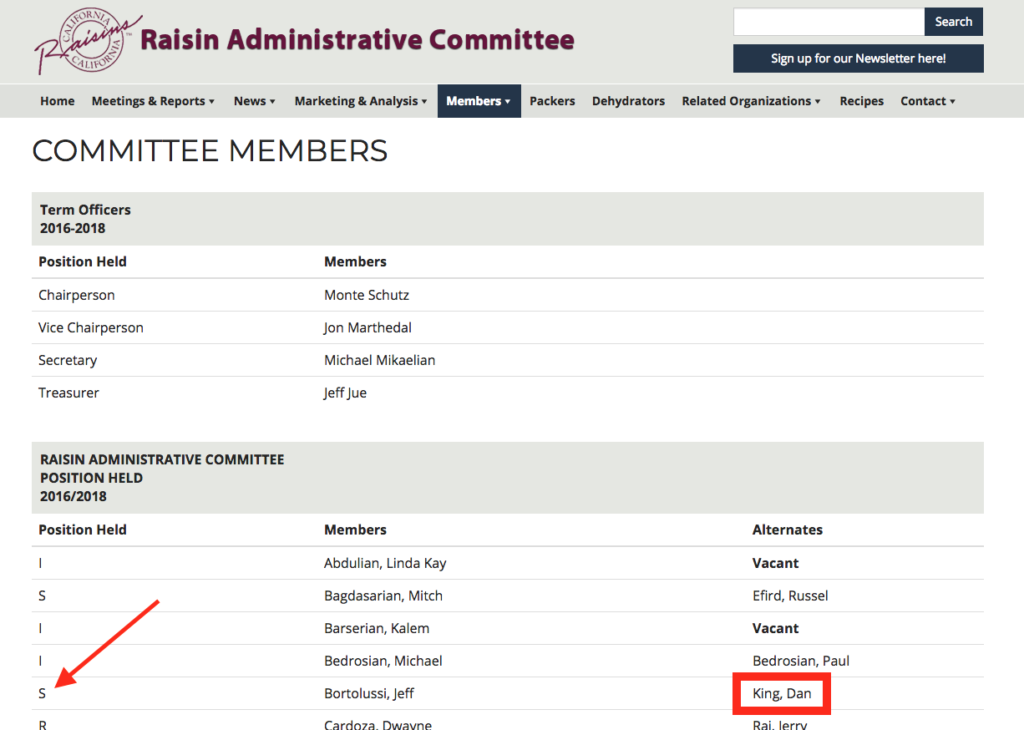In 1937 the US Department of Agriculture picked a group of raisin farmers and handlers and gave them the power to constrict the amount of raisins that all farmers could produce in a given year. This cartel, called the Raisin Administrative Committee, made it a federal crime to attempt to sell more raisins than they determined.
Fun facts: The United States Department of Agriculture, created in 1862, is part of the administrative branch but basically has the power to create laws – a role that’s traditionally reserved for the legislative branch. In 2017 the USDA employed over 105,000 people and had a budget of $151 billion, nearly 8 times NASA’s budget.
Even though cartels, collusion, price-fixing, and other monopolistic practices are clearly violations of US antitrust law, in 1937 a few lucky raisin farmers and handlers became part of a government-protected cartel. The stated purpose of the cartel was to “stabilize” the price of raisins.
Specifically, the Raisin Administrative Committee “a requirement that growers set aside a certain percentage of their crop” to give to the Government, “free of charge.” These raisins are then destroyed, donated, or sold in “noncompetitive” markets, which artificially increases the price of raisins for consumers like you and me (but not my mom – she hates raisins).
In the 2003-2004 growing season, raisin growers were required to set aside 30% of their crop. But that was a relief from the season before when growers were forced to set aside a whopping 47% of their crop.
But like it or not, the rules were the rules. Until they weren’t.
In 2002, when the Raisin Administrative Committee told Marvin and Laura Horne that they could only sell 53% of their raisin crop, they choose to disobey. “The Government sent trucks to the Hornes’ facility at eight o’clock one morning to pick up the raisins,” the Supreme Court opinion reads, “but the Hornes refused entry.”
They were fined $480,000 for the market value of the raisins – even though they would not be compensated that amount when forced to give them to the government – and an additional $200,000 for disobeying orders. Over the next 12 years, the case bounced around various courts until it finally reached the Supreme Court in Horne v. Department of Agriculture.
The court’s opinion was that “Raisins…are private property – the fruit of the growers’ labor – not public things subject to the absolute control of the state.”
Another raisin grower, Dan King, thought that Marvin Horne had acted unfairly: “I think that there’s a set of rules that everybody was playing by during the time that he was not. You know, it’s like everybody stops at the stop sign but not everybody. [If] somebody doesn’t, it causes a problem. And we needed to have the whole industry following the rules or nobody following the rules.”
This is exactly how cartels normally collapse – some members want more for themselves and begin to “cheat.” They produce more than their quota and soon enough everyone is cheating. Except in this case, “cheating” meant competing to supply the right product to the right customer at the right price. While the Supreme Court’s opinion may mean that the cartel members can no longer constrain supply and therefore inflate prices, it also means that consumers pay a lower price on the free market – a clear win for consumers.

While I’m glad that things worked out okay for the Hornes and for US raisin consumers, it does make me think about all the other places where consumers are paying artificially high prices because of cartels and how many of those cartels are being protected by those in power.
And while this is an amazing case of a farmer breaking bad rules in order to change them for the better, there was clearly a large element of “right time, right place” involved in the Horne case. Which makes me wonder: How do you know when to be the raisin rebel or when to surrender to the rules?
Credits & Sources:
I originally heard about the Hornes through the NPR Money podcast – one of my all-time favorite podcasts. And here’s the Supreme Court’s 42 page opinion.